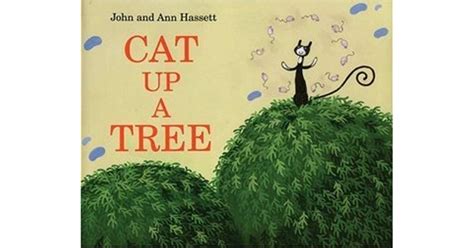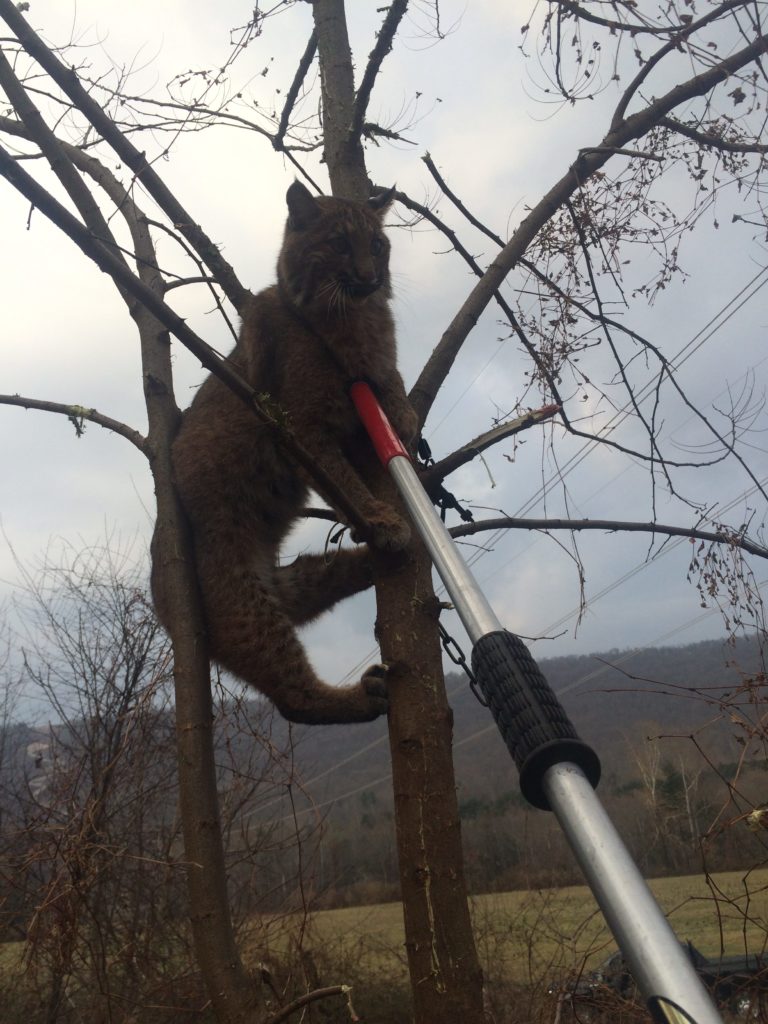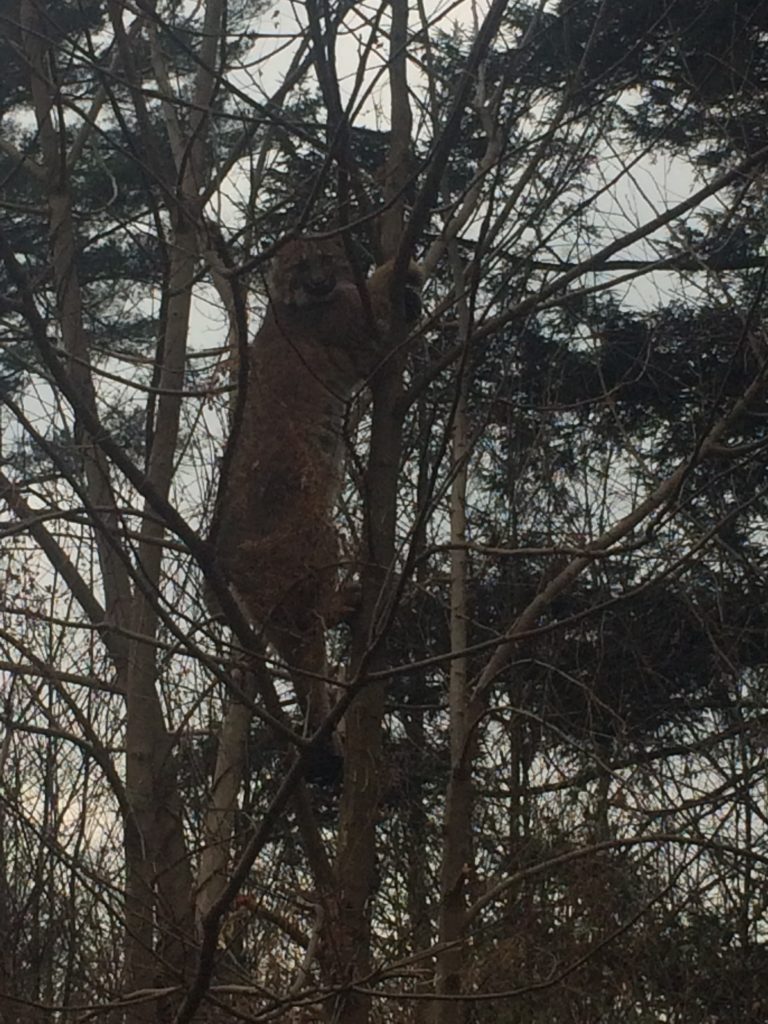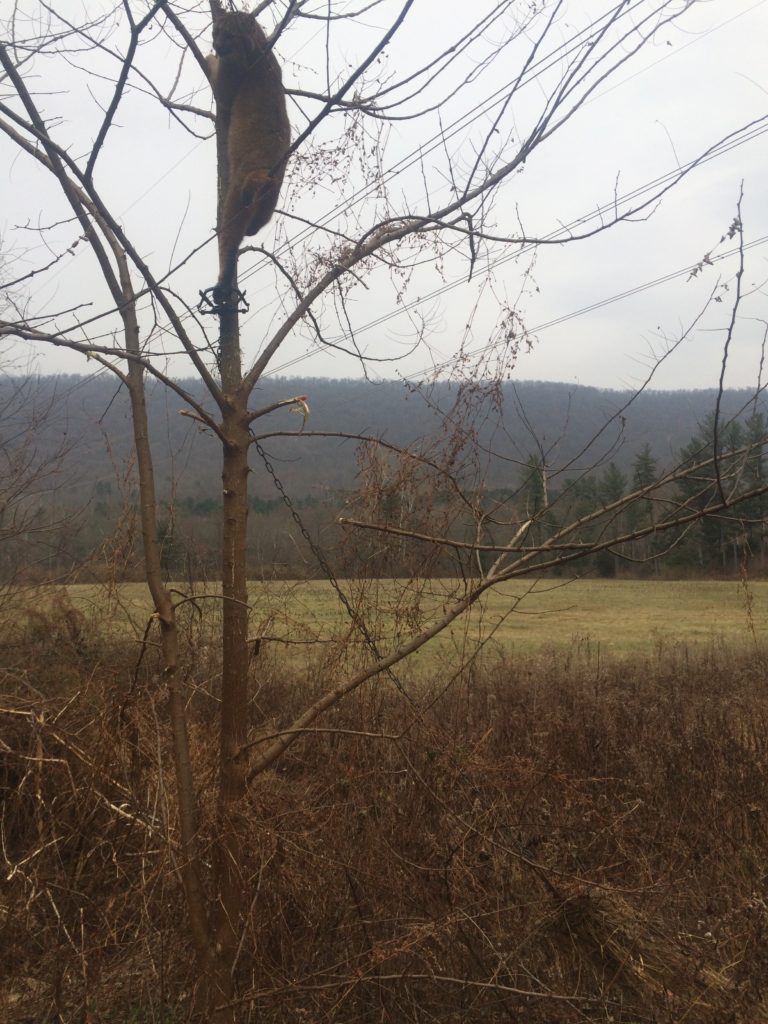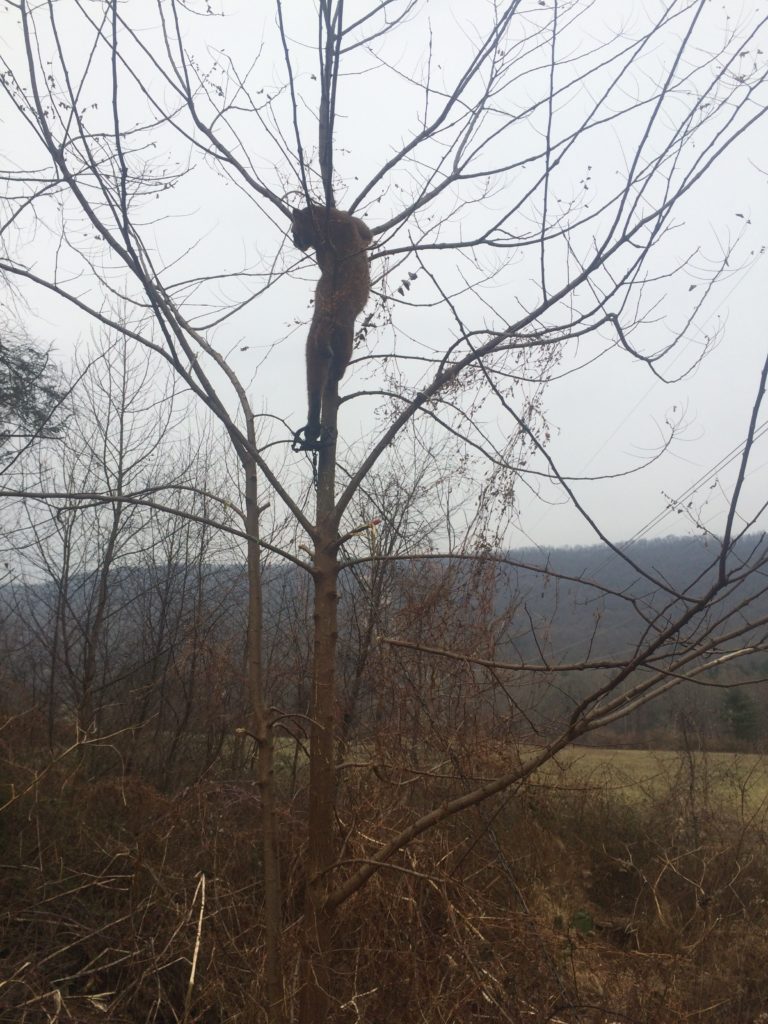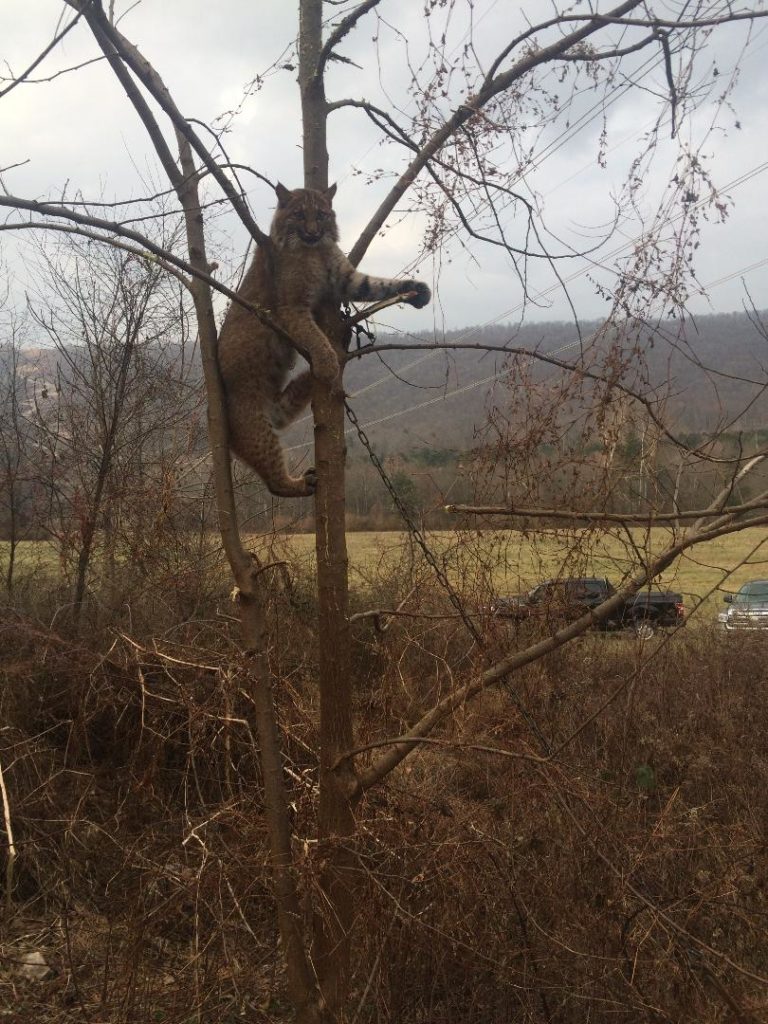Posts Tagged → trap
Turkeys and the critters who eat them
Wild turkeys are one of Pennsylvania’s great conservation success stories. When I was a kid, wild turkeys were like a fable, a mythical animal inhabiting far distant wild lands, that could be seen and maybe heard if you were one of the lucky few. They had been decimated by market hunting in the 1800s and early 1900s. When I took my hunter safety education course at the age of ten at the old Army Reserve building out in the farmland on the east side of State College, the Pennsylvania Game Commission staff proudly showed us films of their successful trap-and-transfer program, where wild turkeys were lured with bait into the range of nets, caught, and then driven to the far reaches of Pennsylvania’s rural areas. Usually State Game Lands with fields.
From the 1970s until the early 2000s, Pennsylvania’s wild turkey population grew and grew, until they seemed to be everywhere, including well south of I-81, the old imaginary dividing line between concrete civilization and wild man country. Apparently turkeys are adaptable to concrete wilderness, because they took up urban residence all over the east coast. Not content with being colorful freeloaders along with the ubiquitous and nasty pigeons and rats in these urban areas from Massachusetts to New Jersey, wild turkeys also provide much hilarity as they attack everything that moves in a display of misguided dominance, including mailmen, soccer moms and their kids, and dogs being walked. Look up the “incident reports” of wild turkey muggings of disbelieving urbanites; lots of funny videos to go along with them, too.
So when turkey populations began to decline in Pennsylvania and parts of New York starting ten years ago, people knew it was not due to the birds’ lack of tenacity. Something new and powerful in the old bird + habitat equation was having an effect.
And in fact in many places here in PA, formerly huge turkey populations are now really low or non-existent. I myself used to look out my windows and watch three separate flocks cycle through our clover-planted yards. When I hunted spring turkeys there (northcentral PA), I would start the day surrounded by gobbling toms, and usually had a couple different opportunities to harvest one within the first few days of the hunting season. It was exciting and fun and a great way to begin the work day, although I will say that by the end of May, I was a hollow shell of a human, having run myself ragged either chasing toms myself, or calling for friends who had not yet filled a tag.
Bottom line is, those old flocks of twenty to thirty birds no longer exist. We are fortunate to see one or two wild turkeys at all on our place. And we have excellent habitat with grouse.
What caused the loss of wild turkeys in PA has generated a discussion similar to the one surrounding the demise of the once amazing world famous smallmouth bass fishery in the lower Susquehanna River. It seems that almost everyone involved has a reasonable opinion about it, and the official experts are being second-guessed by people who have witnessed circumstances different than those described by said experts. The ubiquitous use of trail cameras since 2000 has accompanied this growth in sportsman observational opinion, and very often individual hunters will use their cameras’ footage to make very compelling arguments that contradict official wildlife managers’ narratives.
Something similar happens in the aquatic environment, when thousands of fishermen experience and see something different than what they are being told through official government channels.
So now PGC is toying with the idea of releasing martens into the wilds of Pennsylvania. Similar to the fisher that was released back in the 1990s, martens are a furry little weasel-type animal that, like all weasel type animals everywhere, has an insatiable appetite for everything they can catch and kill. Not necessarily kill and eat. All members of the weasel family (wolverines, fishers, martens, mink, otters, weasels) have periods where they become “surplus killers.” That is, they will kill many more animals than they can eat, just because they seem to enjoy the hunt and the kill. Question being now, What will the new marten do to our turkeys?
Will martens do more of what fishers have so clearly done to PA turkey populations, which is to climb up into trees and eat them while they are roosted and asleep? Will martens only eat turkey eggs? Who knows? And so it follows, why release martens into our forests and farms if we don’t know what impacts they will have?
The question I have, and which I know so many other sportsmen have, is: What kind of studies have been done to date that provide confidence that reintroducing marten will have a net-benefit result, and not a net-negative/cost result?
Most of us agree with government biologists that biodiversity in general is important, and we agree that increasing biodiversity is a worthy goal. But, what are the costs and benefits of doing so? What costs and benefits do marten bring to our forests? I can imagine quite a few costs, mostly impacts on ground nesting birds (like wild turkeys, grouse, pheasant, woodcock, and a zillion species of cute little migratory dickie birds) that are already under tremendous pressure from overpopulating (thanks to urban sprawl) raccoons, skunks, possums, feral cats etc., and I wonder if the benefit of a few hundred citizens annually catching a view of one of these cute and elusive furry weasel-like animals is worth the inevitable costs.
One of the things we must struggle with today is that, as much as we would like to return to the pristine conditions of three hundred or four hundred years ago, where humans had a measurable but relatively minor impact on the environment, the reality on the ground today is totally different. The social carrying capacity among different human groups is one consideration. The carrying capacity of other wildlife is another consideration. I imagine that before people go petitioning or pushing to have these newest predators released back into our forests, we should know what their likely impacts are going to be first. I am willing to sign a petition to have PGC thoroughly study this subject, but I would feel irresponsible to ask the agency to jump before knowing what lies ahead and below.
I will say that I like knowing fishers are in our forests, but I do not like the tremendous impacts they have had on squirrels, rabbits, and turkeys. Everywhere a fisher takes up residence, the small game and turkey populations drop dramatically. Personally, I would prefer to know that there were a few hundred fishers living across Pennsylvania, instead of the thousands we now have that are over-impacting a lot of other equally valuable wildlife (and I enjoy recreationally trapping for fisher every year).
I am not saying that adding martens to Pennsylvania will necessarily be pouring fuel on the fire burning up wild turkey populations, but we really should know. That is the responsible thing to do.
Hunting season withdrawal, carpe diem reminder
Despite hunting a lot this past season, I am going through serious withdrawal symptoms. And mind you, hunting for small game is not done yet, and neither is trapping. And snow geese are in. So field opportunities do remain.
But with the bobcat and fisher trapping seasons now over, the justification for really heading deep into the silent woods has ended. Besides, a fisher just took up residence about 100 yards from the cabin. Only a few weeks after the season ended. It’s a “ha ha” finger in the eye reminder that some things are just not meant to be.
To be honest, I did not trap much this year, due to time limitations that kept me trapping right around where I have been working. And also to the fact that my outdoor work activities scared away the animals that will normally come in to explore the scents we use around our traps. And the freeze-thaw-rain-freeze-thaw-rain cycle of the past couple of years happened yet again during December, our best trapping time. Using footholds in those conditions is tough, because they can move around as the earth thaws during the day and re-freezes at night. When an animal steps on a trap that has moved in its bed, the trap moves under its paw, and then the animal digs up the trap. And If I put out winter-resistant cable restraints in that kind of weather, I can expect a very muddy animal waiting for me. And I am not in the business of shampooing coyotes and foxes. Too much time. So trapping season has pretty much passed me by, though I will try for a specific coyote, and maybe a few more possums in cage traps, just to save some springtime whippoorwill nests from being raided.
A few more squirrel hunts, a rabbit hunt or two with a 1920 Parker Brothers 20 gauge side-by-side, and some predator hunts will be had. Good times for sure, usually with good friends, but the few days of climbing high and sneaking through the quiet snowy mountains are gone. They ended almost before they began.
Hunting season is an annual reminder to grab all of life and squeeze and cajole every bit of living and enjoyment from it that we can, because before we know it, it all ends almost before it began.
At my grandfather’s 100th birthday (he lived almost exactly three more years after), he blew out the candles on his cake and sat back.
“I don’t know where my life went,” he said, staring into his chocolate cake. And he was a guy who had really lived.
My comments to the PA Game Commission
The Pennsylvania Game Commission board of commissioners will be meeting this weekend, to set next season’s dates and bag limits. Like many other people, I submitted comments by email last week. From past experiences with this, I know that the commissioners read comments and requests from the public. Some of my comments, and those of my son, have received direct feedback from various members of the board.
A key to getting the commissioners to read and truly consider your comments is to submit them with plenty of time for the recipients to read them. If you submit comments a day or two before the meeting, it’s a very low likelihood of anyone having time to read them. Also, try to keep comments short, to the point, and sweet. Comments with prolonged bitching, whining, and playing biologist when you have no training or education or even a novice’s interest in wildlife biology, are all ways to ensure that your audience at best glances at your comments.
“Dear Commissioners,
Hunting should be fun, and therefore our small game seasons should run unbroken from their Fall opening to their February close. Whatever long gone reason for the on again-off again pattern of small game seasons, Pennsylvania must create opportunities for everyone. No biological reason exists for hiccup-style seasons. Few if any other states have this odd pattern. Let’s just let our hunters have fun and hunt.
In that vein, please consider allowing bodygrip traps on running pole sets in our most rural WMUs. The idea that a loose domestic dog is going to get caught in a trap in the middle of a state forest wilderness is preposterous. Same is true on private land. Same goes for allowing snares. We need all the tools we can get to manage coyotes. With now three years of crazy freeze-thaw-rain winter weather cycles, it’s impossible to rely on footholds. Cable restraints should be allowed throughout the whole season, and snares should be allowed on private land and or on public land in the Big Woods WMUs.
Finally, please put one of our Sundays on the day after the Saturday bear rifle opener, and another Sunday on the day after the Saturday deer rifle opener. This will create the most energy and excitement for our hunters. Even better, make bear and deer rifle concurrent!
Thank you for considering my thoughts,
–Josh”
This day a year ago while trapping: Cat up a tree!
Cat Up a Tree!
Text and Photos by Josh First (copyrighted)
I dislike trapping in rainy conditions, because it is uncomfortable, messy, and technically difficult, due to trap sets needing constant fixing up; and I really dislike processing muddy critters. Mud-covered fur is time consuming, and usually it is not worth it in my tight schedule. So from 2018’s trapping season opening day in late October, I waited six weeks, until a brief rain lull in mid-December, to put out some carefully planned traps.
Though I was aiming mostly for canids like fox and coyote, both bobcat and fisher were a reasonable hope. I have caught bobcats in and out of season in the past, but never a fisher. These are two neat animals worth working hard for, and each of which will quite willingly enter baited cubbies where foot hold traps can get some shelter from rain and snow.
So on the Wednesday afternoon before that Saturday bobcat and fisher opener, a half-dozen footholds (cubbies and flat sets) and a few large cage traps were set in strategic places near where I had seen fisher tracks or bobcats across a 100-acre area of mixed farmland and woods in Dauphin County. Bait is used in the cage traps to pull in the inevitable and limitless possums, skunks, and raccoons, so that, hopefully, only the cool critters find the footholds. And both bobcats and fishers will enter cage traps, so they do serve double duty.
One pass-through pee post set was put in a location where I have previously caught coyotes, foxes, and raccoons. It is at a corner of a dirt farm road, a woods road, a hay field, and brushy-hedged crop field where heavy woods meets an active agricultural area. Just about every local furbearer walks the brushy area, this road, and the field edges leading to it.
Coyote pee and coyote gland lure were put on top of a two-inch-thick dry pine limb sticking up 14 inches, placed at the seam where the goldenrod meets the farm road. A few pieces of goldenrod stem on the other side created the pass-through effect, so the animal’s body would line up with the hidden trap just exactly so. About eight inches away from the post an offset MB 550 attached to an eight-foot heavy chain linked to a heavy two-prong coyote drag was bedded level atop soft goldenrod tops to protect the trap from freezing to the wet dirt underneath, then covered judiciously in waxed dirt, then finished with more soft goldenrod tops and weed tips blended on top. The trap was perfectly “blended in” and hidden from sight.
The chain was stretched out away, into the reverting goldenrod field, and well covered and camouflaged with weeds, and the rusty-brown colored steel drag itself unobtrusively hooked into the dirt. With four heavy swivels well spaced between the trap and the drag, I felt confident that whatever would step on the trap pan while passing between the weeds to smell the pee post would commit its full weight, and be safely held fast, no matter where it went afterwards. I expected the animal to head directly to the nearby brushy hedges, where the grapple and chain would immediately become entangled, thereby holding the animal for the next 24-hour trap check.
Usually predators take a couple days to fully investigate my traps, and when setting this on a late Wednesday, I anticipated catching something in one of the sets on Friday night/ early Saturday morning. Though aiming for a bobcat, fox, coyote, or fisher, the truth is I had put off trapping so long that season that I would have been happy to catch just about anything.
The next day, Thursday, I did a cursory trap circuit check in my truck, looking out the window while driving past set after set. “No…No…No…footprints all around but no step on the pan…no…no…nothing” as I went by each trap location.
Pulling up to the pee post set, my eye was immediately drawn to the pee post itself lying on the ground, though the trap bed itself did not appear disturbed. Usually the post is knocked over by the chain after an animal has stepped on the trap and fled. So I got out to check, and was not surprised to see the drag gone. Following an obvious path of bent weeds and scuffed dirt leading away towards the closest brushy forest edge, my eyes naturally looked along that edge for a hung-up drag and critter.
With my hands on my hips, I stood and kept scanning the brushy woods-field edge. I was unable to locate anything, and felt mystified about how the critter could have escaped beyond such a thick, natural entanglement area. Mystery remained until a hiss to my right reached my ear, steering my eyes in that direction.
“Why is that long-legged grey fox up in that honey locust like that?” was my first thought.
Then another thought followed the first: “Why does that grey fox look like a big cat?”
And then the bobcat came into focus. It was a nice sized young male, probably 25 pounds, about six feet up in a young honey locust, a tree that has plenty of sharp thorns and very hard wood. The drag was just touching the ground, and the chain was wound about the lowest branches.
OK, I thought, I’ll have this resolved in a few minutes. Seemed like no big deal to pull down the cat, use the catch pole to hold it steady while I released the trap from its foot and let it go unharmed.
Fast forward an hour, and each time I had tried different ways to bring it down out of the tree unharmed, the cat had moved farther up. With bobcat season two days away, by law the cat had to be released, but I was unsuccessful with each solution I tried.
Fretting and scratched by the locust thorns, I left, did some work, and returned a few hours later, hoping the cat had climbed down and was entangled in the ground brush nearby. On the ground it would be easy to release using a catch pole. Easier than up that tree!
But when I got back, the bobcat was still up the tree, and climbed yet higher as I approached it.
Time for Plan B, which is where I admit that I need help. Usually takes me a long, long time to implement Plan B, and so I called the Pennsylvania Game Commission southeastern regional office. At first the dispatcher congratulated me on catching the bobcat, but then moments later expressed his sympathy for me having to release such a fine trophy, as the season was yet to begin. He forwarded my message to a local Game Warden, who then fairly quickly met me right at the honey locust. In fact, he arrived so quickly that I could not help but wonder if he had been watching me the whole time, either chuckling at my clumsy efforts, or waiting to see what else I might do, or both.
“Thank you for coming. When my kids were little, their favorite book was Cat Up a Tree! And here it is in real life. Should we call the fire department?” I said to Game Warden Scott Frederick, half-jokingly. In that colorful book, the fire department saves the day by saving the cat stuck up in the tree, and we (and how I so liked the ‘we’ part) did indeed have a daggone cat way up in a tree. But unlike the book, we had no long ladders, or hero firemen, by the honey locust tree that day.
I asked my wife to film our escapade, but under questioning I revealed that pretty much anything could happen to anybody around this, so she said something like “No, I’m not recording two idiot men playing with matches.” I think her imagination had the warden and I emerging from the dense, high brush scratched head to toe, our clothes in ragged tatters, like some cartoon involving the Looney Tunes Tasmanian Devil. She wanted no part of it. This is why women live longer than men.
Warden Frederick tried to the untangle the chain and reach the animal, but with each new inch of loose chain, the bobcat sensed freedom and used the slack to climb ever higher. Upon reaching a tight chain again, he would stop his ascent, alternating between hissing at us and letting fly with whatever he could rustle up in his bowels. I came to learn that bobcats have an impressive amount and array of bad smells stored inside them. Neither Warden Frederick nor I smelled peachy at that point, but I gave in and laughed at him when he really got it good from the cat.
Eventually we had tried and tried every which way to get the cat down unharmed, the day waxed late, and so we decided that if the cat would not come down, then the tree had to come down.
A honey locust is a hard, tough tree, a pioneer species with twisting grain and sharp hooked thorns. Oftimes while being sawed, they don’t fall the way you think they will. In addition to its loud scary noise, a chain saw would remove too much wood too quickly to allow us to fully control which way the tree would fall, and a hand saw was too slow. So we used an axe to drop the tree, one carefully placed chop at a time. This gave us the best control over the tree’s slow descent, but it was sweaty work, and directly beneath the bobcat. So I let Warden Frederick do it.
Meanwhile, the bobcat climbed to the very top of the tree, clinging like a lookout in a ship’s crow’s nest, and swayed to the rhythm of the chop-chop-chop below.
As the tree gave way to the axe and slowly sank to the ground, the bobcat sensed its getaway approaching. But Warden Frederick was waiting with a catch pole. While I wish I had some humorous Game News Field Note material here to describe what happened next, the truth is Warden Frederick properly and quickly looped the bobcat’s shoulder and neck, under the armpit, thereby safely pinning the animal to the ground without risk to its esophagus (cats have really weak throat areas and they must be handled carefully). I got some last quick photos, threw a blanket over the bobcat to calm him down (the bobcat, not Warden Frederick), and then easily pulled the trap off of its foot.
Both of us inspected its foot and leg for damage, and seeing none, I stepped back, pulled the blanket, and the catch pole loop came off the bobcat. As many other trappers have experienced when releasing a trapped bobcat, this one sat on its haunches and hissed at us. He thought he was still stuck. Eventually he turned and fast- walked into the brush.
“Well, that’s it, I’m now officially jinxed, or ‘lynxed’,” I said to Warden Frederick. “From here on out I will catch only possums and skunks for the rest of the season.”
And in fact, for the rest of that epic rainy trapping season, such as it was, I caught a grand total of just five possums, one skunk, and one raccoon. It was my worst trapping season, numbers-wise, in many years. But in hindsight, it was also pretty rewarding to watch the Game Warden work like that. Both hard and smart, I mean. Citizens don’t get to see our public servants perform these kinds of feats very often, and with a good nature to boot. So in that sense, I had a uniquely good season. Thank you, Warden Frederick. Now I can’t wait for mountain lions to move into Pennsylvania!
[Why do I trap? I trap to save ducklings, goslings, baby songbirds, nesting grouse, woodcock, and turkeys from an endless number of ground predators like skunks, possums, raccoons, foxes and coyotes, all of which continue to pulse out from suburban sprawl habitats in artificially high numbers. These artificially high numbers of predators do tremendous damage to ground nesting birds, and basically cars and trappers are their sole adversaries. So if you are against trapping, you must hate cute little ducklings. Foothold traps do not crush bones or kill animals, they simply hold them, and as we can and did here, animals can be released from footholds totally unhurt]
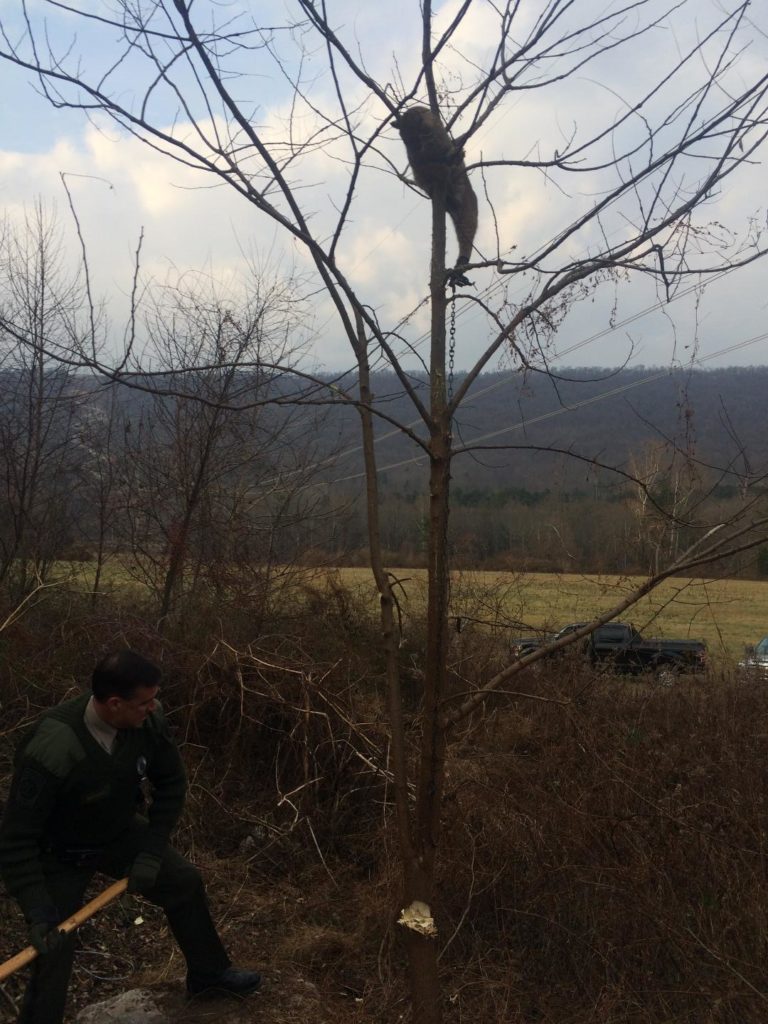
If you ever want to feel like you are getting your tax money’s worth, look closely at this photo of PA Game Warden Frederick chopping at that honey locust. Except that the PA Game Commission operates on hunting license fees, timber sales, and natural gas leases! No tax money goes to the PGC, and yet they provide so many taxpayer services.
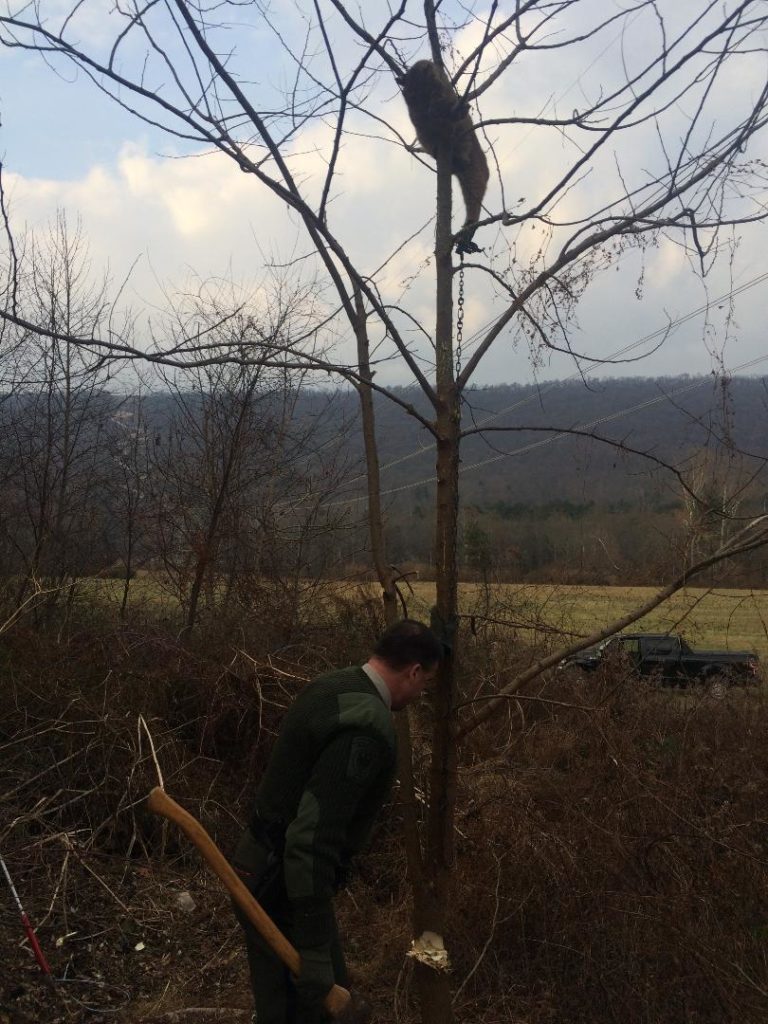
The four swivels and the long chain are visible here. The swivels prevent the chain from binding as the animal moves around, which gives the animal complete 360 degree movement. This is important so the animal does not torque its leg or hurt itself trying to get free. The long chain is needed to get hung up quickly in brush
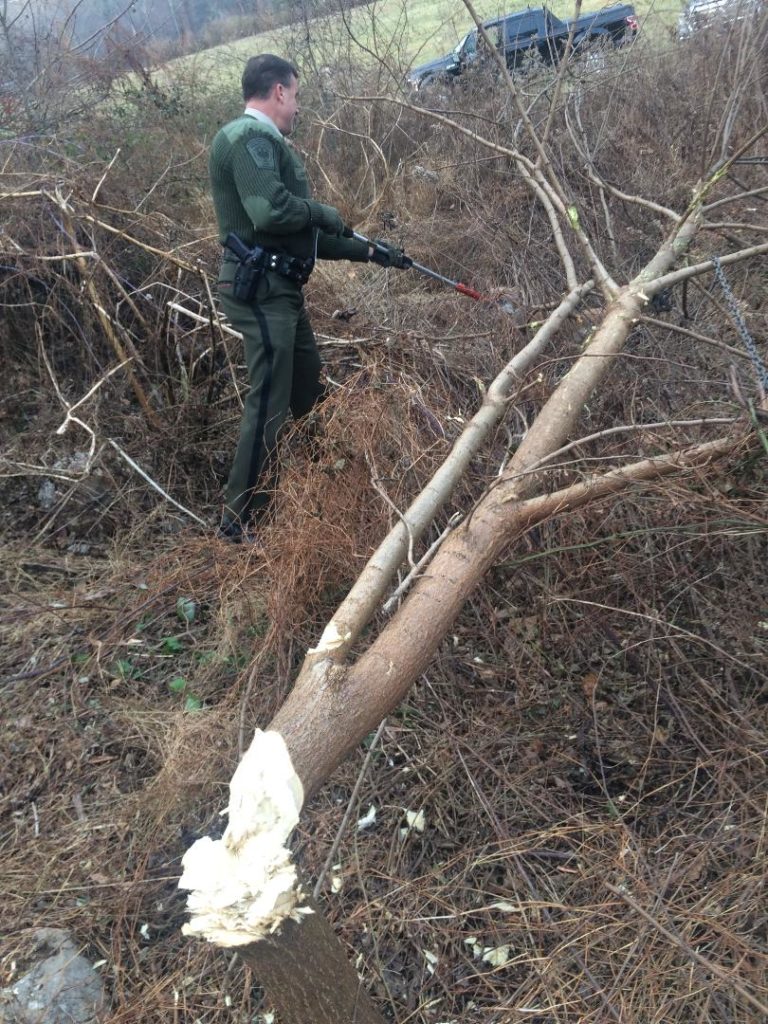
The unharmed bobcat can be seen hissing at Scott, who has the catch pole loop around its upper body, pinning it to the ground. After taking this picture, I threw a blanket (Scott’s, not mine) over it to calm it down, inspected its leg for any damage, and when we each determined the animal was not hurt, Scott then released it. Using a catch pole on a bobcat requires getting the loop under its armpit and around the neck, so the esophagus is not damaged.
It’s that time of year again, Pt. II
It is now “that time of year again,” but Part Two.
A month ago your firewood had better have been laid up and close to perfectly dry, or you were going to have an uncomfortably cold winter in rural America.
Now, a month later, a whole bunch of hunting seasons are upon us. Small game, trapping, deer archery, bear archery…and many people are afield a serious amount of time. Some people try to catch the deer rut in a couple different states with their bow. It can become a crazed time, where the humans are just as worn down and rutted up by the prospect of catching unawares a big old wary buck who, in his brief moment of annual craziness, lets down his guard.
Usually, I do not begin trapping in earnest until December, when all pelts are truly prime and when the bobcat and fisher seasons begin. Early on I set out cage traps to thin out the skunks and possums that will otherwise clog up my best sets later on. Never one to sell furs, trapping for me has always been about helping ground-nesting birds against an overabundance of nest-raiding mammals pulsing out from suburban sprawl habitats. With Russia and China in bad financial and economic situations the past five years, wild fur has not been in as big demand as the past. This lower demand has led many professional trappers to abandon their lines and wait for prices to come back up. In turn, that let-off in trapping pressure results in TONS of raccoons, possums, skunks etc running around. Over the past couple of weeks I have seen more road-kill raccoons than in many years past all together.
And this high population of raccoons means higher rates of rabies, trash-raiding, fights with pets, etc.
My favorite type of hunt is the solo wilderness excursion. Sleeping in a cold tent, bundled against the night time freeze, waking up to some snow on everything, enjoying a hot tea to start the day, and wandering into the wind, trying to find buck or bear tracks. Or in the case of a big male bear, making sure he isn’t on my track, like two years ago.
Is there danger in this? Sure. Then there is danger in being hit by a car, or falling and damaging a body part. There is danger in never experiencing life, and thinking that the modern risk-free cocoon most of us live in is either normal or healthy. It is neither.
And so it is that time of year again, when every fiber in my body says “Get outside, NOW!” It is a time of forgotten or deliberately misplaced professional obligations, phone calls returned on a Friday afternoon, instead of the prior Monday morning. I hope friends and colleagues will forgive me if I am a little late in getting back.
Nature is calling on the phone, it’s for me, and I gotta run.
I’ll be back. Promise.
Public Lands: Public good, public love
Someone named this September “Public Lands Month,” and while I have no idea who did this, or why they did it, I’ll take it nonetheless. Because like the vast majority of Americans, I totally, completely, absolutely love public land. Our public parks, forests, monuments, recreation areas, and wildlife management areas are one of the greatest acts of government in the history of human governments.
As a wilderness hunter, trapper, and fisherman, I truly love the idea of public land, and I love the land itself. No other place provides the lonesome opportunities to solo hunt for a huge bear or buck, either of which may have never seen a man before, or to take a fisher and a pine marten in a bodygripper or on a crossing log drowning rig, than public land.
If you want a representation of what is best and most symbolic of America, look to our public lands. They best capture the grandeur of America’s open frontier, the anvil upon which our tough national character was hammered and wrought. It was on the American frontier that Yankee ingenuity, self-reliance, and an indomitable hunger for individual freedom and liberty was born. And yes, while it was the Indian who reluctantly released his land to us, it was also the Indian who taught us the land’s value, so that we might not squander it, using it cheaply, profligately, and indiscriminately. Public lands are the antidote to our natural inclination to use land the same way we use everything else within our reach.
Some armchair conservatives argue that our public land is a waste of resources. That it is a bottled-up missed opportunity to make even more-more money, and if only we would just blow it all up, pave it all, dam it all, cut it all right now, etc, then someone somewhere would have even more millions of dollars in his pocket, and daggone it, he really wants those extra millions on top of the millions he already has in his pocket. When all our farmland is paved, that same armchair conservative will have nowhere to grow food to feed us, and apparently he will learn to eat dollar bills (he already thinks Dollars are what we survive on, anyhow, so it’ll be an interesting test of reality meeting theory).
But the truth is it’s mentally sick to talk about how much money you can get for selling your mother, or for selling your soul, which is what our land is, take your pick. Hunger for more money than a man knows what to do with, notwithstanding. But some things are just not worth valuing with money, and no number of payments of thirty pieces of silver will ever, ever amount to anything in comparison to what is actually in hand, our public land.
Others complain that public land is communism, but what do they say about the old English and New England commons, where villagers pastured their collected cows? Were our forebears who fought at Bunker Hill fighting for communism? You know they weren’t. Sometimes sharing isn’t a bad thing, and sharing some land is probably one of the best things. If Yosemite or Sequoia National Parks were privately owned, no one from the public would be there, right?
Americans are fortunate to have in their hand millions of acres of public land that they can access, from Maine to Alaska to Hawaii and everywhere in between. Little township and county squirrel parks, big state forests and parks, and vast national parks like the Appalachian Trail and Acadia are all magical experiences available only because they are public.
It is true that LaVoy Finicum was murdered in cold blood by out of control public employees over a legitimate debate with tyrannical, unaccountable public land managers in Oregon. But that is not the fault of the public grazing land there, any more than a murder can be blamed on the gun and not the man who pulled its trigger. We need to hold accountable those who screwed over Finicum and those who murdered him, not blame the land on which it all happened. Despite some failings by public land managers, of which Finicum’s murder is a great and sad example, public land remains one of the very few things that government actually does well and right almost all of the time. Corrective action is just one new administration away, as selected by the voters.
If you want to see untrammeled natural beauty for campers and hikers, or if you want to experience bountiful hunting lands for an afternoon or a week, then look to the public lands near you or far away from you. Everything else – nearly 100% of private lands – is either dead, dying, or slated for eventual execution at the hands of development.
We need a lot more public land in America. We need more to love in life, and nothing compares to loving a whole mountain range, a river, a field or a forest. It will love you back with nurture and sustenance, too.

Hang glider leaps off of Hyner View State Park, surrounded by a couple million acres of Pennsylvania state forest and state parks

Down below Hyner View State Park is the Renova (Renovo) municipal park, with some historical artifacts from past freedom-ensuring conflicts, reminding the next generations of the sacrifices made so they can enjoy iPhones and Starbucks
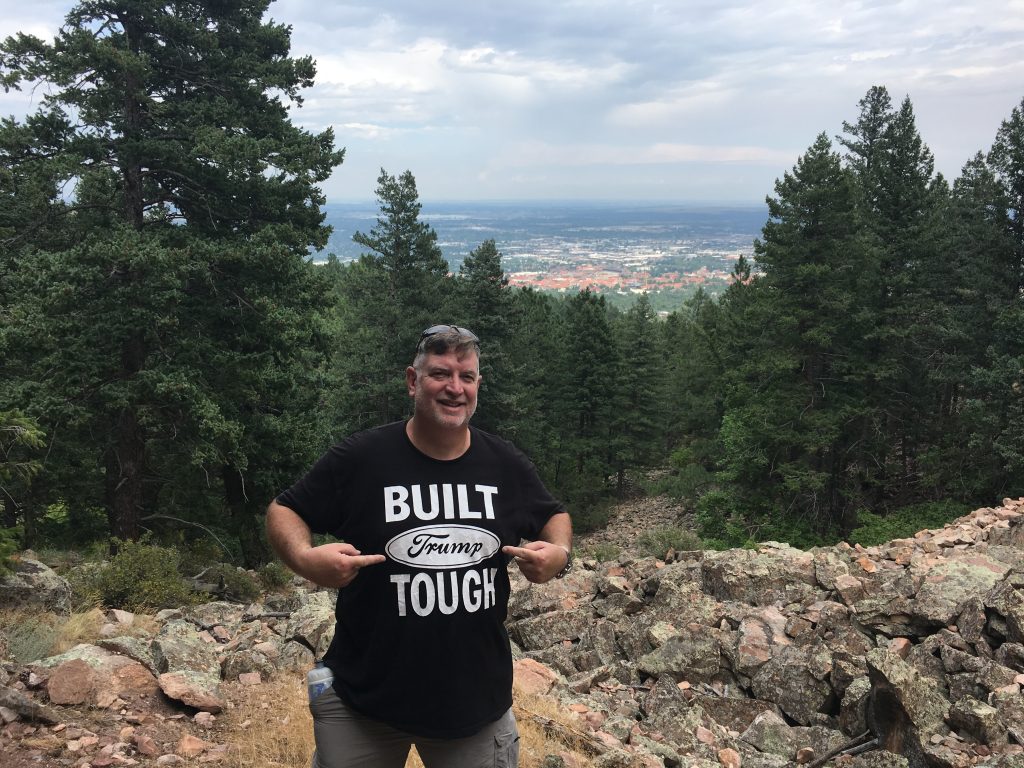
Yours truly standing high up in the Flatirons above super-liberal Boulder, Colorado, in the background, demonstrating “Trump Over Boulder” in case any hikers had missed the shirt. None had missed its presence there, by the way. Lots of public land here, enough for everyone to share, even Donald Trump! (and yes, there are a lot of boulders here in the photo).
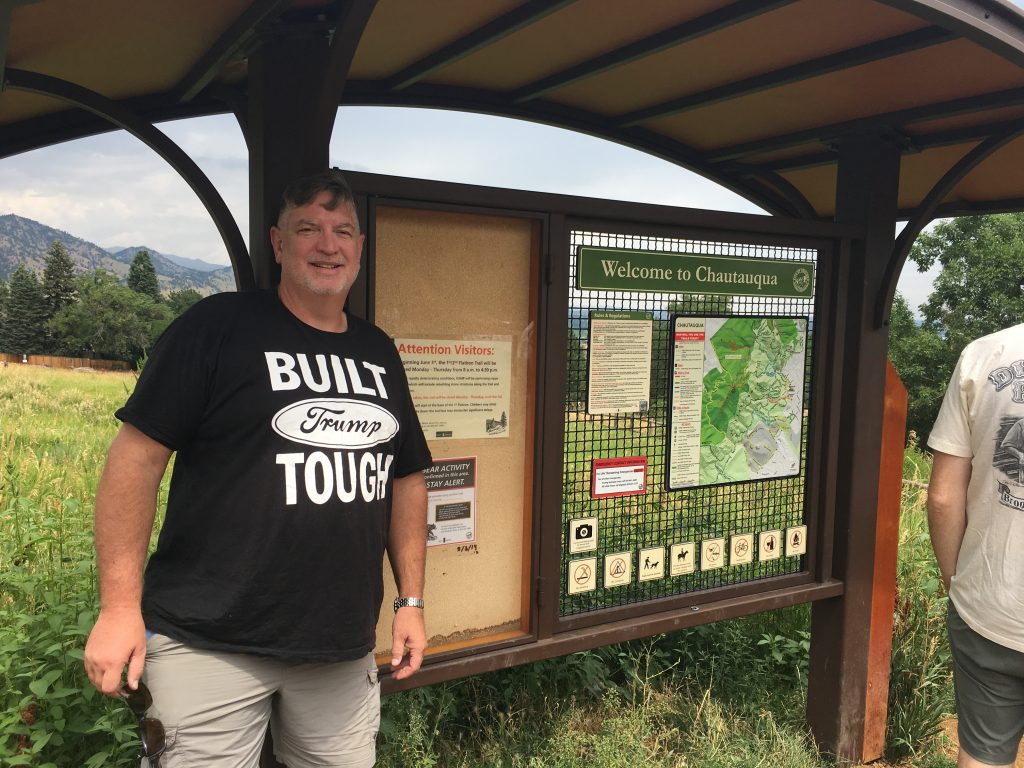
The author malingering around the Boulder, Colorado Chautauqua kiosk, silently taunting the invasive liberals gathered and passing through there. And in fact, the Trump shirt earned many double and triple-takes from fellow hikers, unused to experiencing diversity of thought. I did not bite those people, though I was tempted. Great public lands experience!
PA wildlife: damned if we do, damned if we don’t
Like every other state in the Union, Pennsylvania protects, conserves, and manages its wildlife through a combination of user-pays fees like hunting and fishing licenses on the one hand, and a helping of federal funding collected from user-self-imposed federal taxes on hunting and fishing equipment like boats, guns, ammunition, fishing rods etc on the other hand (the same people who buy the hunting and fishing licenses).
Yes, 100% of the nation’s citizenry benefits from the self-imposed taxes and fees paid by just 1% of the population: the hunters, trappers, and fishermen. Yes, you read that right: just 1% of the population is carrying 100% of the public burden.
And yes, as you are correctly about to say out loud, you and I will not see this bizarre and totally unsustainable arrangement in any other area of public policy. Not in roads, not in schools, not in airports, not in museums, not in anything else official and run for public benefit. And so, yes, it is a fact that wildlife agencies across America are perennially underfunded, and have been for so long that it’s now accepted as the way America does its wildlife business. Here in Pennsylvania, despite endless rising costs and endlessly more expensive public pensions, both houses of the PA legislature have long blocked the PA Game Commission from getting a hunting license increase in decades. So the PGC is even more behind the financial Eight Ball than most other state wildlife agencies. Hunters and wildlife managers in other states look at Pennsylvania and shake their heads. It doesn’t have to be this way, but it is.
Despite the obvious imbalance and weakness inherent in such a unique and faulty funding arrangement, for fifty years this approach worked pretty well, nationally and in Pennsylvania, with some states occasionally putting new money into holes that opened up in the regular wildlife funding support. Those states with significantly increasing human populations tend to be forced into dealing with inevitable wildlife-human conflicts more than other states, and when Mr. and Mrs. America are increasingly hitting deer with their cars, you can bet that they will demand their home state do something about it. So more money is found.
So along comes the Pennsylvania Auditor General, to investigate the management and expenditure of money at the PGC. And why not, right? The PGC is a public agency, and hunting license revenue is a public trust. So sure, go ahead, look into it, audit the agency. And so it was done, and some interesting things emerged just a bit over a week ago.
In the “Atta boy” column is the fact that there appears to be no corruption, graft, or misuse of scarce sportsmen’s dollars at the PGC. By all accounts, PGC is transparent and well run. Given how much the sportsmen are always scrutinizing the agency, we all figured as much. But it is nice to have our beliefs and trust confirmed like this. We love the PGC even more today than before the audit.
In the “Aww shucks” column is the revelation that PGC staff do not immediately deposit oil and gas royalty checks when they are received, nor does the PGC ascertain for itself if those royalty payments are accurate in the first place, instead trusting the oil and gas companies to do what is right on their own. Hmmmm….This is a potential problem area, and we are all glad the auditors found it. Anyone who knows the PGC can bet money on the fact that PGC staff are right now doing all of this payment followup with a vengeance. Look out, oil and gas companies!
But then there is the big weird issue, the biggest issue of all, where the auditors “discover” that the PGC is sitting on $72 million in the bank. And accordingly, the auditors immediately and erroneously ascribe this to bad money management. After all, they say, public money is meant to be spent. “If you got ’em, smoke ’em,” goes the ancient and totally irresponsible government approach to managing public dollars. After all, under normal budgeting culture, agencies that do not spend the money budgeted to them risk losing those dollars in the next budget cycle. Failure to spend money is correlated with a failure to implement an agency’s mission, and for senior agency managers, there is the usual ego factor; the bigger the budget, the bigger the…you know. This is the old approach to managing government funds, and it is wrong, and it certainly does not fit the PGC’s reality or targeted way of doing business.
Let’s ask you a question: If you knew your family was going to be receiving less and less money going forward, and yet your family costs would be held steady, wouldn’t you begin to bank any extra money you had, in preparation for lean times ahead? If your family is responsible, then yes, this is what you do, it is what we all do. And it is what the PGC has done, thankfully.
But as a result of the audit, this single fact is being used to beat on the agency, to coerce the PGC to adopt unsustainable policies and irresponsible money management, despite the agency sailing through ever less sustainable funding waters every day. Seems like now every elected official and every Monday morning quarterback sportsman has some variation on the foolish theme that PGC has more money than it knows what to do with. Wrong!
So the real outcome of the audit is that Pennsylvania wildlife are damned either way, because the PGC is the useful straw man whipping boy for every aspiring demagogue in Pennsylvania politics. No matter what the PGC does, our wildlife resources are going to suffer. If PGC carefully, frugally husbands its limited resources, preparing for rainy days and needy wildlife, then the agency’s critics say the agency is miserly and hoarding, and they seek to punish the agency. And on the other hand, if the PGC immediately spends every dime it has, and has no money left over to deal with yet more unfunded mandates like Chronic Wasting Disease, then critics say the agency is wasteful and ineffective, and they seek to punish the agency.
And either way, the net result is the PGC’s critics damn and condemn our wildlife. Because that is the true result of all this second-guessing and monkeying about with the PGC budget and funding streams. Plenty of elected officials use their criticism of the PGC to artificially burnish their “good government” credentials, when in fact they are demanding the worst sort of government, and a total disservice to the sportsmen and wildlife everyone enjoys.
Many years ago, sportsmen were organized enough to react strongly to political demagogues who threatened our wildlife resource (and PA’s $1.6 billion annual hunting economy) with their petty politics. This latest iteration of the politics of wildlife management indicates that we need to get back to the old days, where sportsmen were unified and forceful, even vengeful, in their expectation that their elected officials would not politicize or hurt our commonly held wildlife resource.
Best time of the year
November through January is the best time of the year.
“It’s Christmas in November, December AND January,” say my fellow outdoorsmen.
From small game in late October to archery for deer, to the current bear season and then rifle season for deer next week, and then trapping season, it’s nonstop action.
With the nonstop political drama and annoying ankle biting behavior of certain partisans representing themselves as news reporters, we can all use a break. I have been enjoying a break. Friends and family hanging out together, eating together, hunting together, and then hanging out again in comfy relaxation, it’s really an unusually best time of the year.
Under no other circumstances can or will so many people take off from work, drive long distances, and see old friends, as we do now. Maybe a big high school reunion will draw in a lot of disparate people from far and wide. But we do this hunting bit every year.
Santa brought us snow early. The better to hunt and track in. The better to hover around a warm fire from. Thank you, Jolly old Chris Cringle!
Everyone enjoy your winter!
Thank you to wildlife’s friends, my friends
When I started writing for Eric Epstein’s Rock the Capitol about eight years ago, one of the first stories I related to readers was an experience two of my children and I had with two pitbulls let off their leashes.
The readership statistics on this one essay were off the charts. Very high volume, and lots of comments. When I asked why, Eric and his website manager, whose name I now forget, told me that news items and stories involving animals claim the biggest share of attention on the Internet.
Fascinating, right?
And we all kind of see this fact in the strange way people routinely show concern for an injured goat in the news by donating a million dollars so the goat can get its broken hoof fixed, and then a truly sad situation involving some news story about a poor unfortunate child whose abusive parents tormented her for years raises just five bucks to get her into a better home.
It is true that people care about animals, and that is a good thing. But this care seems to extend mostly, really overwhelmingly, to domesticated animals; animals that depend upon humans for care and shelter. A natural and healthy empathy is aroused when some unfortunate critter is seen hemmed in by wire or caging, unable to provide for itself and yet not being provided for by the humans around it.
The type of animals people have the least identity with is wildlife. Most Americans, being urban or suburban, simply mythologize wildlife.
From this more urban view, all bears are universally perceived as aggressively dangerous (they are not, though grizzlies are definitely more aggressive than black bears). Deer run out in front of our cars, eat our crops, spread ticks with Lyme Disease, and nibble our yard shrubs, dammit. Squirrels are nasty tree rats with fuzzy tails chewing on our yard furniture, eating the produce of our gardens and fruit trees, and diving our trash bins. And skunks, possums and raccoons are a bunch of rabies-ridden trashcan raiders. And so on.
Wildlife by and large is not greatly appreciated by the general public, unless it is a close-up photo of some baby raccoon or fox kit. And no, I am not talking about wildlife photographers or the insane Humane Society as representative of the general public. These two categories of people are far distant outliers of one sort or another, and no generality can be drawn from their presence among or about wildlife.
So thank God there are sportsmen out there; that is, hunters and trappers. These are the Americans who really do truly care for and about wildlife, and they prove it every damned day with their financial donations and back-breaking work on wildlife habitat projects.
There is no better advocacy group or aggregation of active people who love wild animals and the wild places they need to thrive than hunters and trappers. Time has proven this fact, though the foolish flatlander will claim, with a mouthful of gross stockyard beef in her mouth, that hunting and trapping are “cruel.”
Most of our public lands were first acquired by and for hunting and trapping, at the urging of hunters and trappers. They knew in the 1890s and 1920s that human encroachment into formerly wild areas was leaving no room for the most interesting animals on earth. Many of these animals are more interesting than most of the humans we will encounter in any given day, week, month, or lifetime.
This weekend I really enjoyed my time among a special group of people, the state-wide leadership of the Pennsylvania Federation of Sportsmen and Conservationists (PFSC), what until yesterday was known as the Pennsylvania Federation of Sportsmen’s Clubs (PFSC). Most Americans no longer know that the word “sport” is about hunting, fishing, and trapping, nor do they know what a ‘sporting club’ is about. The lexicon has changed as the daily experience has changed. Meat is no longer acquired from a wild animal who knew it was hunted, but rather from a miserable creature tormented from its earliest days until its last moment alive and turned into a convenient styrofoam package.
The PFSC folks are the people who work every day for the benefit of wildlife, for wildlife habitat, for the defense and promotion of our state parks, state forests, and state game lands. These people do it humbly, quietly, generously, and usually all they get in return is some self-satisfaction from sitting back after a grouse hunt and, despite an empty game bag, intently watching a mysterious red Fall sunset streaked with white wispy trailing clouds sinking down behind shadowy trees shedding their colorful leaves. A deeply comforting stillness overtakes these people at these moments, alone or with companions, and when they go home that night, they know their decades of work fundraising for the latest land acquisition by the Wildlands Conservancy has paid off. It might be a relatively small nook in a big world, but it is a special nook nonetheless, where wildlife — wild animals unknown and unloved by most people — can call home until the next glacier comes through and re-orders the earth’s surface, as has already happened many times in the past.
Here is to you, a heartfelt thank you, my friends, my companions, my betters and my teachers among the outdoorsman fellowship. Thank you for your time and gift to me and to everyone and every living thing around me, whether they know or know not what you do for us.
Our Wildlife Management Comments Submitted to the PA Game Commission
Dear PGC Commissioners,
In so many ways the Game Commission is on an exciting path, really moving forward on policy, staff culture, and scientific wildlife management. It is an exciting time to be a hunter and trapper in the great state of Pennsylvania, thanks to you. Hunting and trapping are supposed to be fun, and the PGC should be able to maximize opportunities without sacrificing the natural resource base. If anything, the agency has been perhaps too conservative, too cautious. In that vein, here are some small suggestions for improving hunting and trapping in Pennsylvania:
a) Make all small game seasons concurrent, start them in late September or early October and run them unbroken until mid February. The current on-again-off-again schedule is silly, an artifact from many decades ago. Our current small game hunting schedule leaves kids and oldsters alike out in the cold with nothing to hunt if they can’t get to deer camp, or if they do kill a deer and want to keep on hunting. Hunters deserve maximum opportunities that do not degrade or put wildlife populations at risk, and adding a few extra days won’t hurt anything, but they will help hunters tremendously. Put another way, the risk of changing this is very low to non–existent, and the benefits are huge. Well, what is the risk, really?
b) Allow the use of snares in rural WMUs and/or on private lands. Cable restraints are an important trapping tool under any circumstances, and especially so as we experience ever-increasing freeze-thaw-freeze-thaw winters, with rain no less. These weird winter conditions render traditional footholds nearly useless both early and late in the season. Cable restraints can function better than footholds under those conditions, but they just are not sufficient for the big coyotes we are encountering. Getting coyotes into cable restraints is tough enough, and holding them there is even tougher. Chew-throughs of our cables are common, where a snare would positively catch the coyote and hold it, bringing it to hand and into the bag. In rural areas (or on private land) there is a far lower expectation or risk of a pet or feral dog or cat being caught. We are ceding too much to the anti-trappers by prohibiting snares where they can do the best good. A pet is an animal that lives in a home. Eliminating a very useful tool because of some vague or low-probability worry is not good policy. We can do better, and snares are much better than cable restraints in general, and particularly in the northern Big Woods areas. Also, CR certification can only be done right in person, through hands-on training. This online certification is going to lead to problems, especially where CRs are used like snares.
c) Allow the use of body-grip (Conibear) traps outside water courses, specifically on running-pole sets for fishers, bobcats, and raccoons. Like the snare situation above, our trapping regulations are unrealistic, they are too conservative, penalizing law-abiding trappers because of vague fears that under reasonable circumstances will not happen. Securing body-grip traps up off the ground is well out of the reach of dogs and domestic cats. Separately, if a pet owner lets their animal out the door to run free, where it can trespass, be hit by a car, be eaten by a coyote or fox or hawk, or get hurt in a fight with another animal, then they do not truly care about it and it is not a real “pet.” Pennsylvania trappers do not deserve to be hurt because of others’ irresponsible behavior. Elsewhere in America, the use of bodygrips on running pole sets is very effective and humane. We can stick with the #160 size as the maximum.
d) Extend the fisher trapping season and areas. Trappers in Berks and Lebanon Counties have told me of catching fishers in their sets, and we are seeing them in Dauphin County. There is no good reason why we cannot extend where and when we trap these abundant predators. Incidentally, they eat bobcats and turkeys, and it would be silly to expect fishers to simply harmoniously co-exist with other animals. They are a voracious predator and they will have a disproportionate impact on predator and prey populations alike if allowed to expand unchecked. Fishers are cool animals and I am all for having them in our ecosystems. What is lacking now are the mountain lions and wolves that in the distant past would have eaten them, and kept them in balance with other wildlife. We humans now fulfill the role of lions and wolves. Let us at ’em.
e) Make sure bobcat populations can sustain these long trapping and hunting seasons. We are seeing a lot less bobcat sign and fewer bobcats on our trail cameras. This was the first year we did not get a bobcat through either trapping or calling in 2G and 4C, and while this may be just our observation, we are concerned. If bobcat harvests must be reduced, then we prefer that it come out of their hunting season. There is a ton of hunting opportunities in Pennsylvania, and not a lot of great trapping opportunities. Heck, muskrats are practically extinct, coyotes have eaten most of the red fox in the southcentral, and possums are clogging nearly every trap. Let us keep our bobcat trapping intact.
f) Reinstate concurrent buck and doe deer hunting. We are seeing a high number of deer nearly every place we hunt (WMUs 2G, 4C, 3A, 5C, 5D). Deer populations are definitely lower than in 2001, and deer are harder to hunt now than then, but the quality is unbelievable, and the herd can sustain both doe and buck hunting. Pennsylvania is now a real trophy destination, so keep up the scientific management, which would include allowing hunting on Christmas Day.
g) Expand the bear season by one day in WMUs 2G and 4C, or rearrange the season entirely. There are an awful lot of bears everywhere, especially in 2G and 4C. On the Friday before bear season starts, we see loads of bears having tea and crumpets in the back yard. They are watching football and hanging out leisurely in reclining chairs. Come Opening Day through Wednesday, we might see the hind end of a bear or two, or we might occasionally harvest a bear, if we work hard enough. By deer season opening day the following week, the bears are back to having tea and crumpets in the back yard, hardly disturbed by all our hunting efforts. Another way to address this is to make bear and deer seasons concurrent, at least for one week, and perhaps start that concurrent season the week of Thanksgiving.
h) Do more to end wildlife feeding. We continue to see mangy bears, and deer baiting under the guise of “helping” wildlife through artificial feeding. It’s not good for the animals, and can actually be bad. People also feed wildlife to entice game animals away from (other) hunters. This is a cultural practice that PGC needs to do more to end, through education and enforcing the bear feeding regulation.
Thank you for considering our comments. We do love the PGC and admire your field staff, especially.
Josh and Isaac First (father and son)
Harrisburg, PA
